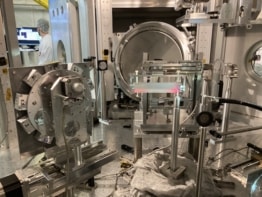
A new way of generating linearly polarized photons using quantum dots has been developed by an international team of researchers. The photons are emitted from a quantum dot at the top of a semiconductor “micropyramid”, creating an efficient source of polarized light that could be used to develop energy-saving computer and mobile-phone screens, as well as wiretap-proof communications.
A quantum dot (QD) is a semiconductor nanocrystal that displays quantum-mechanical properties thanks to its minute size. The electronic characteristics of QDs are dependent on the size and shape of the individual crystal. As their size and band gap are inversely related, the excitation and photon-emission properties of QDs are highly tuneable.
Predefined polarization
Researchers have long studied QDs and their many possible applications, which include medical imaging and disease detection, LEDs, solar cells and photovoltaics. QDs could also prove to be useful in quantum computing and quantum encryption because they are capable of emitting single photons. But getting the QDs to emit photons that have a predefined polarization has proved difficult and this is an essential requirement for many applications such as LCD screens.
Most devices that create polarized light do so by sending unpolarized light through a polarizing filter. However, at least half of the light (and so an equal amount of energy as heat) is lost in the process, thus making it rather inefficient. To avoid these losses, a better method would involve directly generating polarized light from the source itself. While researchers have known that this is possible with QDs, until now the polarization has either been weak or hard to control and the methods to do it are complex and cumbersome.
But now, Per Olof Holtz of Linköping University in Sweden and colleagues, along with other researchers in Thailand, have come up with an alternative method where asymmetrical quantum dots of indium gallium nitride (InGaN) are grown on top of elongated microscopic six-sided gallium nitride (GaN) pyramids. It is the predefined elongation of the micropyramid that determines the polarization direction of the emitted photons. “We’re demonstrating a new way to generate polarized light directly, with a predetermined polarization vector and with a degree of polarization substantially higher than with the methods previously used,” says Holtz.
Top of the pyramid
The researchers constructed arrays of GaN micropyramids, one atom layer at a time, and coated them with layers of indium just a few nanometres thick. Asymmetrical InGaN quantum dots form at the apex of each pyramid. The team then used a continuous-wave ultraviolet laser operating at 266 nm to excite the QDs and found that photons are emitted with a well-defined wavelength and that the light showed a high degree of linear polarization, on average 84%.
Holtz told physicsworld.com that nitride-based semiconductors are favourable for the generation of polarized light because of their valence-band structure. “We have identified the split-off energy as the key parameter, which will determine the degree of polarization for a given asymmetry,” he says. “In principle, the material with the smallest split-off energy will exhibit the highest degree of polarization, because of enhanced band mixing.” He also points out that it is possible to control the direction of the polarization thanks to the elongated pyramidal dots – something that previous methods could not do.
Many advantages
While the QDs that the team used emit violet light with a wavelength of 415 nm, the photons can, in principle, take on any colour within the visible spectrum by simply varying the amount of the indium used. The researchers’ theoretical calculations also point to the fact that an increased amount of indium in the QDs further improves the degree of polarization. The team says that its method should allow the fabrication of ultracompact arrays of photon emitters, with a controlled polarization direction for each individual emitter.
The researchers point out that their method also has other advantages: their QDs can be used at high temperatures; a higher degree of polarization can be achieved using InGaN dots compared with other semiconductor materials; and the method is compatible with current electronic-processing techniques. Their results could help with the building of more energy-effective polarized LEDs in the light source for LCD screens, as well as in quantum-encryption technologies.
The research is published in the Nature periodical Light: Science & Applications.


